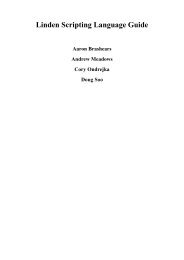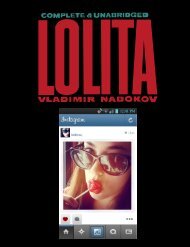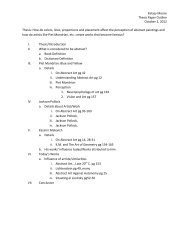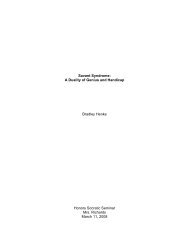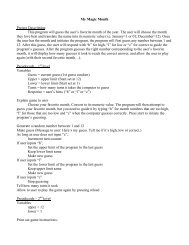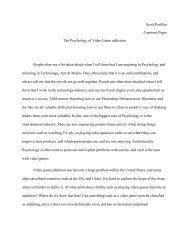Historical investigation of Jacques-Louis David's Marat à son ...
Historical investigation of Jacques-Louis David's Marat à son ...
Historical investigation of Jacques-Louis David's Marat à son ...
You also want an ePaper? Increase the reach of your titles
YUMPU automatically turns print PDFs into web optimized ePapers that Google loves.
How did <strong>Jacques</strong>-<strong>Louis</strong> David’s <strong>Marat</strong> à <strong>son</strong> dernier soupir influence<br />
the popular mindset in France during the French Revolution from 1793-1870?<br />
Jessica Ryan<br />
Loveland High School<br />
Loveland, Colorado, USA<br />
Contents<br />
Plan <strong>of</strong> the Investigation 2<br />
Summary <strong>of</strong> Evidence 2<br />
Evaluation <strong>of</strong> Sources 3<br />
Analysis 4<br />
List <strong>of</strong> Sources and Word Count 5<br />
Appendix A – <strong>Marat</strong> à <strong>son</strong> dernier soupir by <strong>Jacques</strong>-<strong>Louis</strong> David 6<br />
Appendix B – “The Divine <strong>Marat</strong>,” Charles Baudelaire 7
David‟s <strong>Marat</strong> and the French Revolution Ryan 2<br />
A<br />
Plan <strong>of</strong> the Investigation<br />
The purpose <strong>of</strong> this <strong>investigation</strong> is to determine how <strong>Jacques</strong>-<strong>Louis</strong> David‟s<br />
painting, <strong>Marat</strong> à <strong>son</strong> dernier soupir, influenced the popular mindset during the French<br />
Revolution. The two main sources for this <strong>investigation</strong> are the painting itself and “The<br />
Divine <strong>Marat</strong>,” a review <strong>of</strong> the painting by Charles Baudelaire. Also included in this<br />
<strong>investigation</strong> will be essays analyzing the painting, reviews <strong>of</strong> the painting by people<br />
seeing it for the first time, and works containing biographical information about the artist<br />
and the painting‟s subject. Both sides <strong>of</strong> how the painting influenced the general<br />
populace, both for and against the revolution, will be taken into account. Also investigated<br />
will be the history <strong>of</strong> the scene depicted in the painting, as well as the artist‟s relationship<br />
with <strong>Marat</strong> and the revolution.<br />
B<br />
Summary <strong>of</strong> Evidence<br />
<strong>Marat</strong> à <strong>son</strong> dernier soupir is more than just a painting; it tells the story <strong>of</strong> a man<br />
“à <strong>son</strong> dernier soupir”- at his last breath. Jean-Paul <strong>Marat</strong> was a journalist, a politician,<br />
and, finally, a murder victim. Murdered while taking a medicinal bath at his Parisian<br />
apartment by a woman from Normandy named Charlotte Corday, <strong>Marat</strong>‟s place as l’ami<br />
du people (the friend <strong>of</strong> the people) came to an end, one day short <strong>of</strong> the fourth<br />
anniversary <strong>of</strong> the Storming <strong>of</strong> the Bastille. <strong>Marat</strong>‟s close friend, <strong>Jacques</strong>-<strong>Louis</strong> David,<br />
was commissioned in August <strong>of</strong> 1793 by members <strong>of</strong> the National Convention to paint the<br />
deceased‟s likeness, “which reveals an interesting faith in the power <strong>of</strong> the image to<br />
create a likeness so believable that the subject‟s actual presence might be felt” (Vaughan<br />
et al. 6). The painting shows <strong>Marat</strong> as David might have seen him, but “the artist has in<br />
fact been extremely cavalier with the evidence” (Vaughan et al. 16). Upon examination <strong>of</strong><br />
the actual murder scene, one can see the great deal <strong>of</strong> artistic license used by David.<br />
Yes, the <strong>Marat</strong> portrays a murdered man in the bath, but everything else about the scene<br />
is different from how it actually happened- from the shape <strong>of</strong> the bathtub to the<br />
appearance <strong>of</strong> the murder weapon (Vaughan et al. 16).<br />
After its completion, <strong>Marat</strong> à <strong>son</strong> dernier soupir was placed on display at the<br />
Louvre alongside another commemorative portrait by David, a visual ode to Le Peltier de<br />
Saint-Fargeau. A month later, David showed the <strong>Marat</strong> to the Convention, making a<br />
speech regarding his compliance <strong>of</strong> their requests to “Avenge <strong>Marat</strong>.” David‟s speech<br />
was “greeted with applause” and <strong>Marat</strong> à <strong>son</strong> dernier soupir was displayed opposite<br />
David‟s painting <strong>of</strong> Le Peltier. (Schama 224). Noting the opportunity for the <strong>Marat</strong> to<br />
become a piece <strong>of</strong> Revolutionist propaganda, “arrangements were made for 1000 printed<br />
reproductions to be made so that it could be circulated through all the departments <strong>of</strong><br />
France” (Schama 226). The propaganda was effective, as “zealous parents renamed<br />
their children <strong>Marat</strong>; and even towns changed their names to immortalize the fallen<br />
sainted Friend <strong>of</strong> the People” (Schama 227).<br />
However, the <strong>Marat</strong> and Le Peltier were exhibited only for a short amount <strong>of</strong> time;<br />
as political ideals began to shift, the main concepts <strong>of</strong> the paintings became taboo<br />
(Vaughan et al. 68). Worried it would encourage people to focus on matters outside the<br />
home (the antithesis <strong>of</strong> the government <strong>of</strong> the Republic‟s ideal man), the <strong>Marat</strong> was<br />
“banished from public view” until after David‟s death (Halliday 69). The artist himself was<br />
also seen as a threat to the new government and was “denounced in the Convention as a<br />
„tyrant <strong>of</strong> the arts‟ and a traitor” (Schama 227).
David‟s <strong>Marat</strong> and the French Revolution Ryan 3<br />
Although <strong>Marat</strong> à <strong>son</strong> dernier soupir had been hidden for many years, the<br />
painting‟s intended message had a revival in the middle <strong>of</strong> the nineteenth century:<br />
Even after the first Republic began to be rehabilitated in the 1840s,<br />
<strong>Marat</strong> remained condemned as a monster. Jules Michelet, in his classic<br />
study, used <strong>Marat</strong>‟s physical repulsiveness to enhance repugnance:<br />
„from what swamp has come this shocking creature?‟ he asked. Not<br />
surprisingly, Michelet exalts Corday‟s character and beauty in his work.<br />
However, in the 1860s, when republican sympathies were beginning to<br />
revive, <strong>Marat</strong> began to be seen by some in a more sympathetic light.<br />
Alfred Bougeart, in <strong>Marat</strong>, l’ami du peuple, considered that <strong>Marat</strong> had<br />
been a check on unlicensed authority and felt that he would have saved<br />
the Revolution had he lived.<br />
(Vaughan et al. 18)<br />
In 1846, Charles Baudelaire viewed the <strong>Marat</strong> for the first time, writing a review <strong>of</strong> it<br />
entitled “The Divine <strong>Marat</strong>.” Baudelaire‟s description <strong>of</strong> the painting may have played a<br />
role in the movement toward the people‟s sympathy <strong>of</strong> <strong>Marat</strong>.<br />
C<br />
Evaluation <strong>of</strong> Sources<br />
The two main sources for this <strong>investigation</strong> are <strong>Jacques</strong>-<strong>Louis</strong> David‟s painting,<br />
<strong>Marat</strong> à <strong>son</strong> dernier soupir, and Charles Baudelaire‟s critique <strong>of</strong> the work. These are the<br />
main sources because the painting is the basis <strong>of</strong> the <strong>investigation</strong>, and Baudelaire‟s<br />
critique thrust the painting into the spotlight by creating a reputation <strong>of</strong> an unusual and<br />
complex work (Vaughan et al. 20). The painting and Baudelaire‟s critique can be found in<br />
Appendices A and B, respectively.<br />
As David‟s painting is the basis for this <strong>investigation</strong>, its origin, purpose, value,<br />
and limitations must be evaluated and discussed. <strong>Marat</strong> à <strong>son</strong> dernier soupir, as<br />
mentioned in part B <strong>of</strong> the <strong>investigation</strong>, began as a commissioned work to honor the<br />
“Friend <strong>of</strong> the People,” Jean-Paul <strong>Marat</strong>. The painting is a primary document in the sense<br />
that it records the event <strong>of</strong> <strong>Marat</strong>‟s last breath, regardless <strong>of</strong> the portrayal‟s accuracy.<br />
Simon Schama writes, “[David‟s] first obligation was to make <strong>Marat</strong> … into a neoclassical<br />
quasi-biblical hero; someone whose face and body were transfigured into the<br />
highest ideal <strong>of</strong> humanity by sheer force <strong>of</strong> inner virtue” (221). Aside from having been<br />
requested to paint the image <strong>of</strong> his friend‟s dying moments, <strong>Jacques</strong>-<strong>Louis</strong> David created<br />
the <strong>Marat</strong> to display a martyr <strong>of</strong> the Revolution and to immortalize the journalist in the<br />
form <strong>of</strong> an object to which mourners and descendants <strong>of</strong> the Revolution could pay tribute<br />
(Halliday 56). The painting itself is incredibly valuable to historians studying how David<br />
wanted people to see <strong>Marat</strong>, assuming the researcher had a background in art history<br />
and art analysis. Despite its importance as the first portrayal <strong>of</strong> <strong>Marat</strong>‟s murder, <strong>Marat</strong> à<br />
<strong>son</strong> dernier soupir has its limitations. David is clearly biased in his representation <strong>of</strong><br />
<strong>Marat</strong>, hoping to make him appear an innocent martyr. David completely transforms the<br />
scene <strong>of</strong> the crime, changing the color and decoration <strong>of</strong> the walls, adding a letter and<br />
other writing utensils to the scene, even changing the texture <strong>of</strong> <strong>Marat</strong>‟s skin, ignoring the<br />
psoriasis which caused him to be in the bath to begin with (Schama 221). People viewing<br />
the work as an account <strong>of</strong> the murder must take care not to assume its total unbiased<br />
accuracy.
David‟s <strong>Marat</strong> and the French Revolution Ryan 4<br />
Charles Baudelaire‟s critique <strong>of</strong> the <strong>Marat</strong>, entitled “The Divine <strong>Marat</strong>,” also must<br />
be assessed in the ways <strong>of</strong> origin, purpose, value, and limitations, as it is <strong>of</strong>ten regarded<br />
as “the most famous description <strong>of</strong> the picture” (Vaughan et al. 19). Baudelaire‟s critique<br />
is a primary document, originating from an exhibition <strong>of</strong> works by David and Ingres in<br />
1846, half a century after the painting‟s original creation. Baudelaire intended to describe<br />
the painting as he saw it and to reflect on his own per<strong>son</strong>al beliefs about the “conflict<br />
between the real and the ideal” (Vaughan et al. 20). “The Divine <strong>Marat</strong>” can be incredibly<br />
valuable to historians studying the effect <strong>Marat</strong> à <strong>son</strong> dernier soupir had on the art scene<br />
fifty years after its conception because it has been widely accepted as the “classic<br />
formulation” <strong>of</strong> the painting (Vaughan et al. 19). Biographers <strong>of</strong> Baudelaire could also find<br />
“The Divine <strong>Marat</strong>” valuable in deciphering how he was influenced by the painting. But as<br />
with any critique, Baudelaire‟s is incredibly biased and therefore has just as many limits in<br />
its credibility. Baudelaire even makes a plea to the people <strong>of</strong> France to “give way to<br />
emotion before David‟s masterpiece” (Baudelaire). Anyone reading “The Divine <strong>Marat</strong>”<br />
will be able to clearly distinguish Baudelaire‟s favor <strong>of</strong> the painting – even upon<br />
examination <strong>of</strong> the title, one can discern how the writer feels. Due to its slanted approach<br />
to describing the painting, historians must take care to avoid assuming Baudelaire spoke<br />
for the masses in his reaction to the work.<br />
D<br />
Analysis<br />
David clearly took advantage <strong>of</strong> his artistic license while painting <strong>Marat</strong>, taking<br />
every detail <strong>of</strong> the scene <strong>of</strong> the murder and simplifying it (Gretton 35). Instead <strong>of</strong> being<br />
distracted by the cluttered walls in the background <strong>of</strong> the painting, the viewer sees a<br />
black wall which takes up nearly half the canvas. The parallels created by the bathtub<br />
and the writing crate, as well as the diagonal lines created by <strong>Marat</strong>‟s arms and face help<br />
the viewer focus on the body‟s position- strikingly similar to that <strong>of</strong> Michelangelo‟s Piéta<br />
(Schama 221). David simplified the scene not only to emphasise the horror <strong>of</strong> the murder,<br />
but also to make it linger permanently in the people‟s minds. “Somehow, without robbing<br />
the history <strong>of</strong> its particulars, he had to make it seem a moment <strong>of</strong> eternity, pregnant with<br />
destiny not just for France but for all mankind” (Schama 223). With the obvious<br />
connections to Michelangelo‟s image <strong>of</strong> Christ, David successfully paints (quite literally)<br />
<strong>Marat</strong> as a martyr to the cause <strong>of</strong> the people.<br />
David‟s masterpiece fulfilled one <strong>of</strong> its duties in allowing the members <strong>of</strong> the<br />
Convention to have one <strong>of</strong> their own with them again, if only for a short while. Additionally,<br />
<strong>Marat</strong> à <strong>son</strong> dernier soupir served as a way to further the cause <strong>of</strong> revolution:<br />
This…was part <strong>of</strong> a deliberate campaign to use pictures <strong>of</strong> revolutionary<br />
martyrs to replace religious imagery. It was done quite literally at times;<br />
new images actually took the place in some churches <strong>of</strong> old religious<br />
ones. From September 1793 to March 1794 there was a strong „culte de<br />
<strong>Marat</strong>.‟<br />
(Vaughan et al. 17)<br />
Among the 1000 copies sent throughout France as propaganda (Schama 224) were<br />
copies produced by David‟s students from inside his studio. Many copies lacked the<br />
inscription on the crate (“À MARAT, DAVID.”) altogether, while some had a new phrase-<br />
N’AYANT PU ME COMPRIMÉ, ILS ON M’ASSASSINÉ (“Unable to corrupt me, they assassinated
David‟s <strong>Marat</strong> and the French Revolution Ryan 5<br />
me”). This message clearly served David‟s propagandist ideals and helped to strengthen<br />
the “culte de <strong>Marat</strong>.”<br />
Along with the banishment <strong>of</strong> his efforts to honor his friend, David was also<br />
banished- to pri<strong>son</strong>, five days after the execution <strong>of</strong> Jean-<strong>Jacques</strong> Robespierre (Schama<br />
227). During his (two) stints in pri<strong>son</strong>, David spent time crafting a new image for himself.<br />
Instead <strong>of</strong> the politics-driven propagandist responsible for the <strong>Marat</strong>, David painted a self<br />
portrait, turning himself “into the man he was before the Terror; younger, more innocent,<br />
untouched by politics” (Schama 228). David‟s newly rediscovered past self, in addition to<br />
the disappearance <strong>of</strong> the <strong>Marat</strong> allowed people to easily forget the “martyr” portrayed by<br />
David. With the disappearance <strong>of</strong> the “culte de <strong>Marat</strong>,” the new Republic was able to turn<br />
him yet again into a monster, and until the time <strong>of</strong> Baudelaire‟s critique, David‟s victim<br />
remained seen as such.<br />
E<br />
Conclusion<br />
Beginning with David‟s <strong>Marat</strong> and ending with Baudelaire‟s critique <strong>of</strong> it, the<br />
popular mindset regarding <strong>Marat</strong> and the Revolution went through phases <strong>of</strong> favor and<br />
disfavor. From the “culte de <strong>Marat</strong>” created right after the painting‟s first exhibition, to the<br />
renewal <strong>of</strong> pre-<strong>Marat</strong> ideas <strong>of</strong> the subject as a monster, to yet another period <strong>of</strong> sympathy<br />
for the victim <strong>of</strong> the woman from Normandy, <strong>Marat</strong> à <strong>son</strong> dernier soupir greatly influenced<br />
the popular mindset <strong>of</strong> the French people. The absence <strong>of</strong> David‟s painting in the public<br />
eye produces hostility toward the murderous beast, while its presence generates<br />
compassion for the martyr. From this observation, one can conclude David successfully<br />
portrayed <strong>Marat</strong> appropriately in the painting, making him l’ami du peuple for eternity.
David‟s <strong>Marat</strong> and the French Revolution Ryan 6<br />
F<br />
List <strong>of</strong> Sources<br />
Baudelaire, Charles. “Le Musée classique du Bazar Bonne-Nouvelle,” Le Corsaire-Satan,<br />
21 January 1846 ; reprinted in Ouvres complètes. Paris :Gallimard, Pléiade<br />
edition, 1976, 410.<br />
David, <strong>Jacques</strong>-<strong>Louis</strong>. <strong>Marat</strong> à <strong>son</strong> dernier soupir (The Death <strong>of</strong> <strong>Marat</strong>). 1793. Musées<br />
royaux de Beaux-Arts, Brussels.<br />
Delécluze, E. J. <strong>Louis</strong> David, <strong>son</strong> école et <strong>son</strong> temps. Paris, 1855 ; reprint ed. Jean<br />
Pierre Mouilleseaux. Paris: Editions Macula, 1983.<br />
Gretton, Tom. “<strong>Marat</strong>, L’ami du Peuple, David.” David’s The Death <strong>of</strong> <strong>Marat</strong>. eds. William<br />
Vaughan and Helen Weston. New York: Cambridge University Press, 2000.<br />
Halliday, Tony. “David‟s <strong>Marat</strong> as Posthumous Portrait.” David’s The Death <strong>of</strong> <strong>Marat</strong>. eds.<br />
William Vaughan and Helen Weston. New York: Cambridge University Press,<br />
2000.<br />
Norton, Anne. Bloodrites <strong>of</strong> the Post-Structuralists: Word, Flesh, and Revolution. New<br />
York: Routledge, 2002.<br />
Schama, Simon. The Power <strong>of</strong> Art. New York: HarperCollins Publishers, 2006.<br />
Vaughan, William. “Terror and the Tabula Rasa.” David’s The Death <strong>of</strong> <strong>Marat</strong>. New York:<br />
Cambridge University Press, 2000.<br />
Vaughan, William, Helen Weston, Tom Gretton, and Tony Halliday. <strong>David's</strong> The Death <strong>of</strong><br />
<strong>Marat</strong>. New York: Cambridge University Press, 2000.<br />
Weston, Helen. “The Corday-<strong>Marat</strong> Affair.” David’s The Death <strong>of</strong> <strong>Marat</strong>. eds. William<br />
Vaughan and Helen Weston. New York: Cambridge University Press, 2000.
David‟s <strong>Marat</strong> and the French Revolution Ryan 7<br />
Appendix A – <strong>Marat</strong> à <strong>son</strong> dernier soupir by <strong>Jacques</strong>-<strong>Louis</strong> David<br />
<strong>Jacques</strong>-<strong>Louis</strong> David, <strong>Marat</strong> à <strong>son</strong> dernier soupir (The Death <strong>of</strong> <strong>Marat</strong>),<br />
1793, oil on canvas, 165x128 cm. Musées royaux de Beaux-Arts,<br />
Brussels. (Copyright IRPA, Musées royaux de Beaux-Arts, Brussels).
David‟s <strong>Marat</strong> and the French Revolution Ryan 8<br />
Appendix B – “The Divine <strong>Marat</strong>,” Charles Baudelaire<br />
The divine <strong>Marat</strong>, one arm hanging out <strong>of</strong> the bath, its hand still loosely holding<br />
on to its last quill, and his chest pierced by the sacrilegious wound, has just<br />
breathed his last. On the green desk in front <strong>of</strong> him, his other hand still holds the<br />
treacherous letter: „Citizen, it is enough that I am really miserable to have a right<br />
to your benevolence.‟ The bath water is red with blood, the paper is bloodstained;<br />
on the ground lies a large kitchen knife soaked in blood; on a wretched<br />
packing case, which constituted the working furniture for the tireless journalist we<br />
read: „À <strong>Marat</strong>, David‟. All the details are historical and real, as in a novel by<br />
Balzac; the drama is there, alive in all its pitiful horror, and by a strange stroke <strong>of</strong><br />
brilliance, which makes this David‟s masterpiece and one <strong>of</strong> the great treasures<br />
<strong>of</strong> modern art, there is nothing trivial or ignoble about it. What is most astonishing<br />
in this exceptional poem is the fact that it is painted extremely quickly, and when<br />
one considers the beauty <strong>of</strong> its design, it is all the more bewildering. It is the<br />
bread <strong>of</strong> the strong and the triumph <strong>of</strong> the spiritual; as cruel as nature, this<br />
picture has the heady scent <strong>of</strong> idealism. What has become <strong>of</strong> that ugliness that<br />
Death has so swiftly erased with the tip <strong>of</strong> its wing? <strong>Marat</strong> can henceforth<br />
challenge Apollo; Death has kissed him with loving lips and he rests in the peace<br />
<strong>of</strong> transformation. There is in this work something both tender and poignant, a<br />
soul hovers in the chilled air <strong>of</strong> this room, on these cold walls, around the cold<br />
and funereal bath. May we have your permission, politicians <strong>of</strong> all parties, even<br />
you, ferocious liberals <strong>of</strong> 1845, to give way to emotion before David‟s<br />
masterpiece? This painting was a gift to a tearful nation, and our own tears are<br />
not dangerous.



 restaurant"
>
restaurant"
>



